Organising a 1 Day Seminar for Foreign Guests to a Company
VerifiedAdded on 2023/03/17
|11
|2226
|87
AI Summary
This project focuses on organising a one-day seminar for ABC Company to discuss the emerging trends in Big Data and its benefits. It covers project objectives, deliverables, milestones, technical requirements, and customer review.
Contribute Materials
Your contribution can guide someone’s learning journey. Share your
documents today.
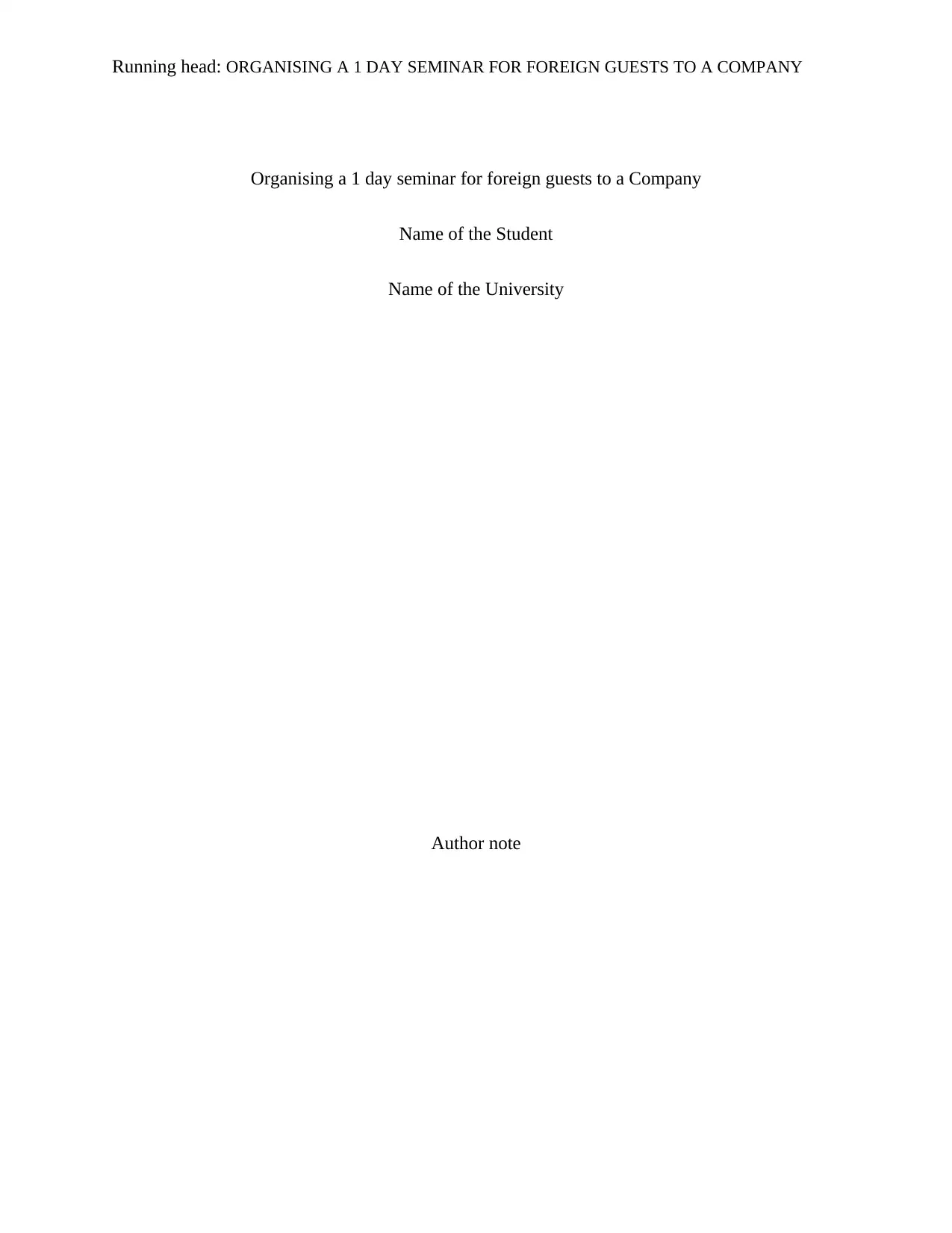
Running head: ORGANISING A 1 DAY SEMINAR FOR FOREIGN GUESTS TO A COMPANY
Organising a 1 day seminar for foreign guests to a Company
Name of the Student
Name of the University
Author note
Organising a 1 day seminar for foreign guests to a Company
Name of the Student
Name of the University
Author note
Secure Best Marks with AI Grader
Need help grading? Try our AI Grader for instant feedback on your assignments.
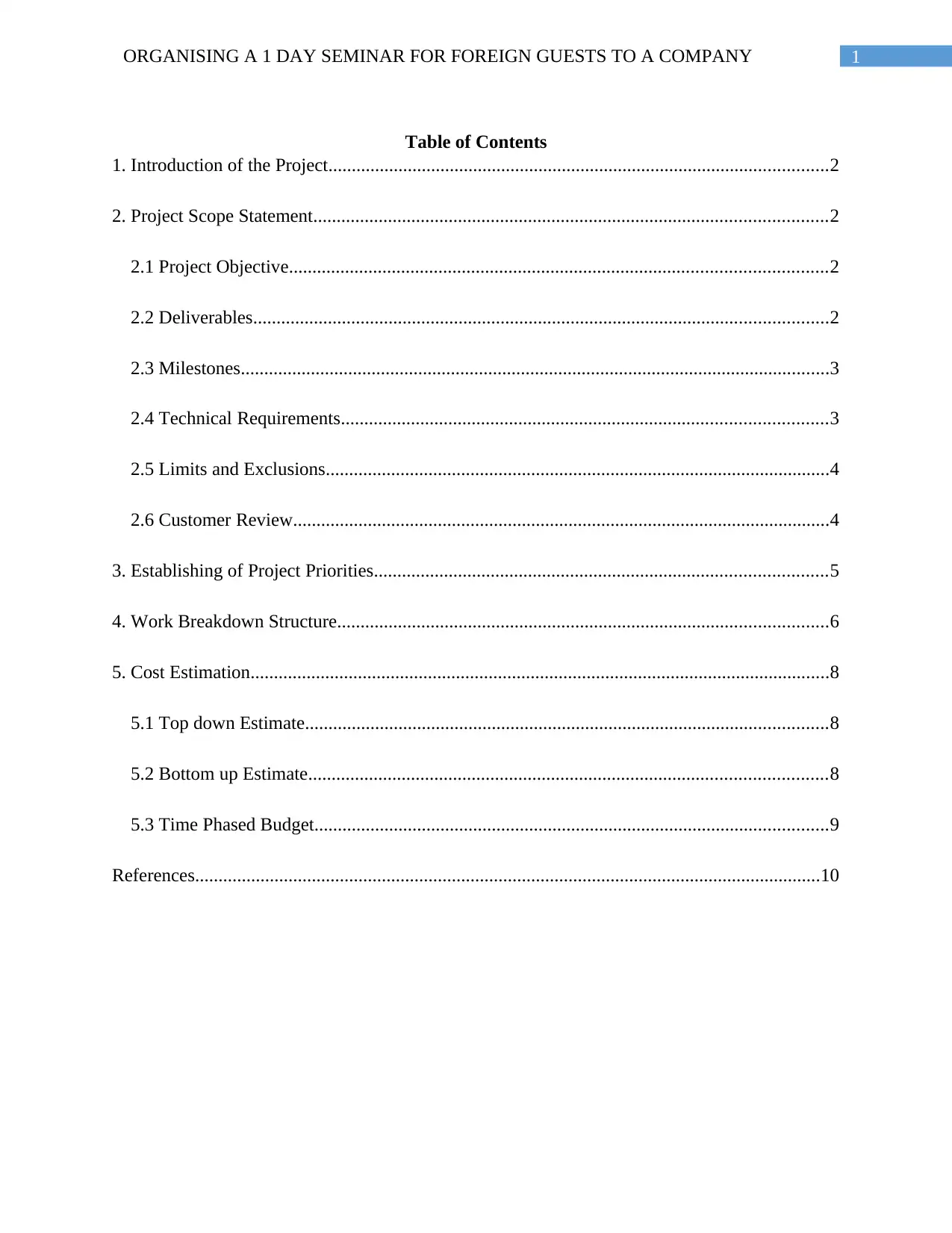
1ORGANISING A 1 DAY SEMINAR FOR FOREIGN GUESTS TO A COMPANY
Table of Contents
1. Introduction of the Project...........................................................................................................2
2. Project Scope Statement..............................................................................................................2
2.1 Project Objective...................................................................................................................2
2.2 Deliverables...........................................................................................................................2
2.3 Milestones..............................................................................................................................3
2.4 Technical Requirements........................................................................................................3
2.5 Limits and Exclusions............................................................................................................4
2.6 Customer Review...................................................................................................................4
3. Establishing of Project Priorities.................................................................................................5
4. Work Breakdown Structure.........................................................................................................6
5. Cost Estimation............................................................................................................................8
5.1 Top down Estimate................................................................................................................8
5.2 Bottom up Estimate...............................................................................................................8
5.3 Time Phased Budget..............................................................................................................9
References......................................................................................................................................10
Table of Contents
1. Introduction of the Project...........................................................................................................2
2. Project Scope Statement..............................................................................................................2
2.1 Project Objective...................................................................................................................2
2.2 Deliverables...........................................................................................................................2
2.3 Milestones..............................................................................................................................3
2.4 Technical Requirements........................................................................................................3
2.5 Limits and Exclusions............................................................................................................4
2.6 Customer Review...................................................................................................................4
3. Establishing of Project Priorities.................................................................................................5
4. Work Breakdown Structure.........................................................................................................6
5. Cost Estimation............................................................................................................................8
5.1 Top down Estimate................................................................................................................8
5.2 Bottom up Estimate...............................................................................................................8
5.3 Time Phased Budget..............................................................................................................9
References......................................................................................................................................10
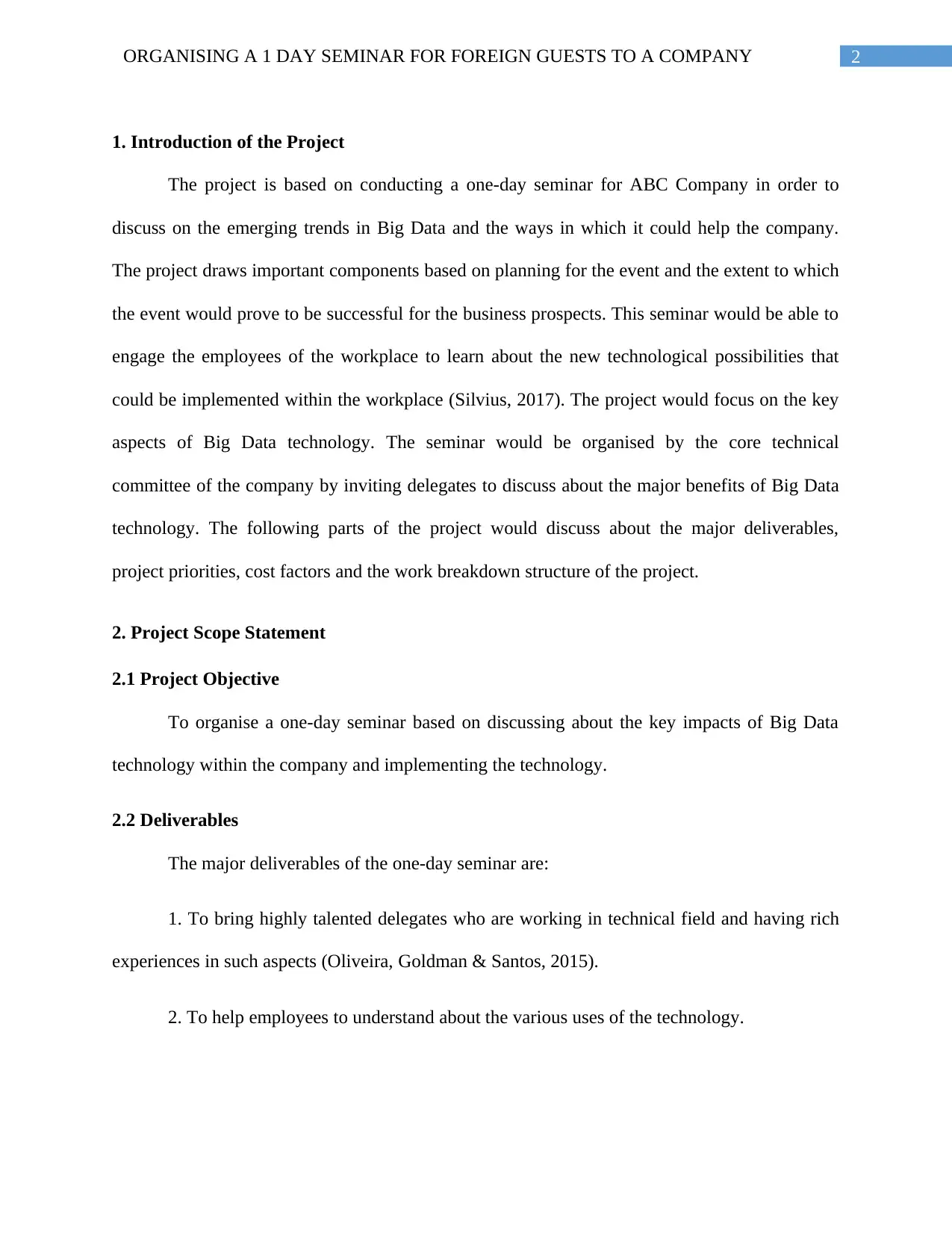
2ORGANISING A 1 DAY SEMINAR FOR FOREIGN GUESTS TO A COMPANY
1. Introduction of the Project
The project is based on conducting a one-day seminar for ABC Company in order to
discuss on the emerging trends in Big Data and the ways in which it could help the company.
The project draws important components based on planning for the event and the extent to which
the event would prove to be successful for the business prospects. This seminar would be able to
engage the employees of the workplace to learn about the new technological possibilities that
could be implemented within the workplace (Silvius, 2017). The project would focus on the key
aspects of Big Data technology. The seminar would be organised by the core technical
committee of the company by inviting delegates to discuss about the major benefits of Big Data
technology. The following parts of the project would discuss about the major deliverables,
project priorities, cost factors and the work breakdown structure of the project.
2. Project Scope Statement
2.1 Project Objective
To organise a one-day seminar based on discussing about the key impacts of Big Data
technology within the company and implementing the technology.
2.2 Deliverables
The major deliverables of the one-day seminar are:
1. To bring highly talented delegates who are working in technical field and having rich
experiences in such aspects (Oliveira, Goldman & Santos, 2015).
2. To help employees to understand about the various uses of the technology.
1. Introduction of the Project
The project is based on conducting a one-day seminar for ABC Company in order to
discuss on the emerging trends in Big Data and the ways in which it could help the company.
The project draws important components based on planning for the event and the extent to which
the event would prove to be successful for the business prospects. This seminar would be able to
engage the employees of the workplace to learn about the new technological possibilities that
could be implemented within the workplace (Silvius, 2017). The project would focus on the key
aspects of Big Data technology. The seminar would be organised by the core technical
committee of the company by inviting delegates to discuss about the major benefits of Big Data
technology. The following parts of the project would discuss about the major deliverables,
project priorities, cost factors and the work breakdown structure of the project.
2. Project Scope Statement
2.1 Project Objective
To organise a one-day seminar based on discussing about the key impacts of Big Data
technology within the company and implementing the technology.
2.2 Deliverables
The major deliverables of the one-day seminar are:
1. To bring highly talented delegates who are working in technical field and having rich
experiences in such aspects (Oliveira, Goldman & Santos, 2015).
2. To help employees to understand about the various uses of the technology.
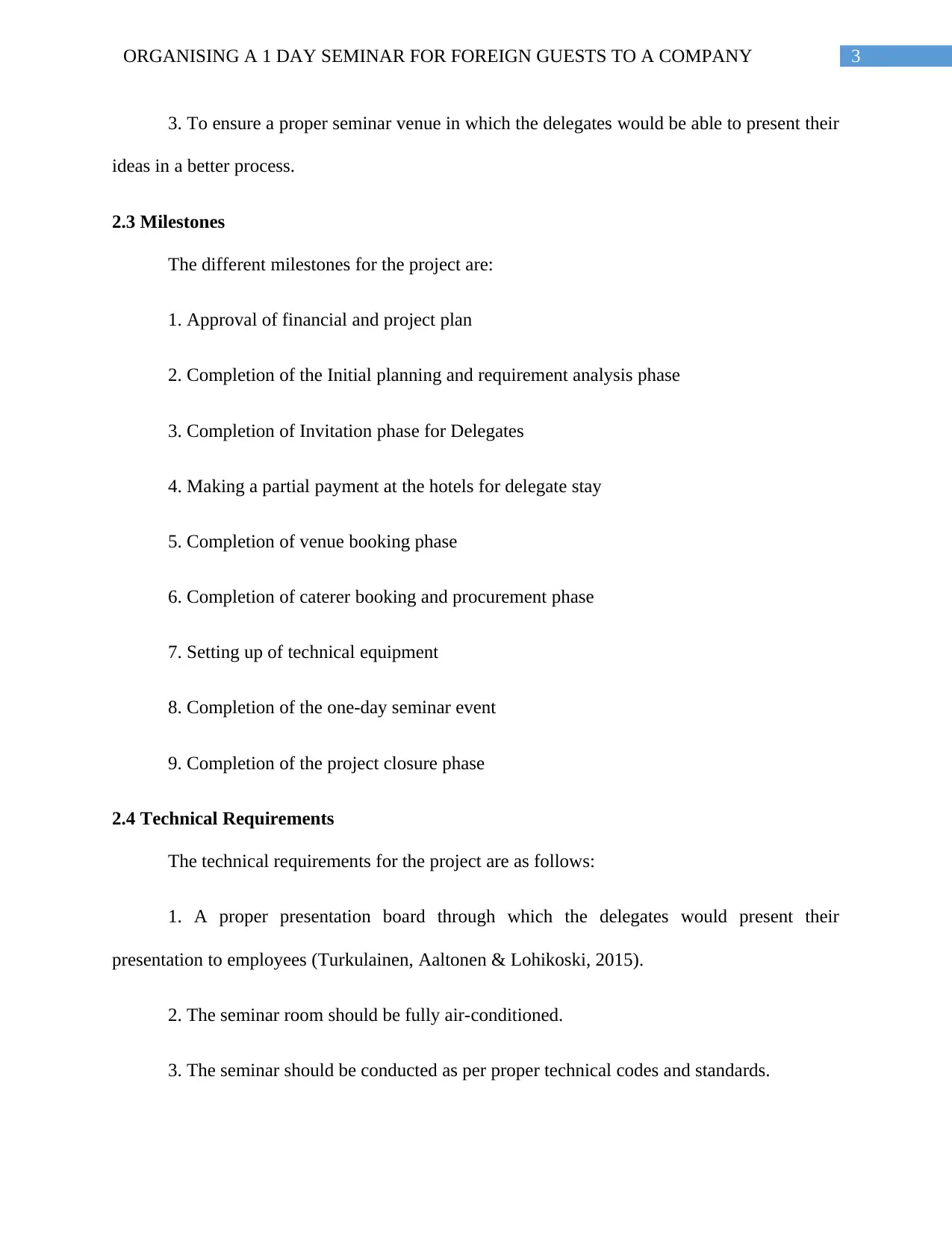
3ORGANISING A 1 DAY SEMINAR FOR FOREIGN GUESTS TO A COMPANY
3. To ensure a proper seminar venue in which the delegates would be able to present their
ideas in a better process.
2.3 Milestones
The different milestones for the project are:
1. Approval of financial and project plan
2. Completion of the Initial planning and requirement analysis phase
3. Completion of Invitation phase for Delegates
4. Making a partial payment at the hotels for delegate stay
5. Completion of venue booking phase
6. Completion of caterer booking and procurement phase
7. Setting up of technical equipment
8. Completion of the one-day seminar event
9. Completion of the project closure phase
2.4 Technical Requirements
The technical requirements for the project are as follows:
1. A proper presentation board through which the delegates would present their
presentation to employees (Turkulainen, Aaltonen & Lohikoski, 2015).
2. The seminar room should be fully air-conditioned.
3. The seminar should be conducted as per proper technical codes and standards.
3. To ensure a proper seminar venue in which the delegates would be able to present their
ideas in a better process.
2.3 Milestones
The different milestones for the project are:
1. Approval of financial and project plan
2. Completion of the Initial planning and requirement analysis phase
3. Completion of Invitation phase for Delegates
4. Making a partial payment at the hotels for delegate stay
5. Completion of venue booking phase
6. Completion of caterer booking and procurement phase
7. Setting up of technical equipment
8. Completion of the one-day seminar event
9. Completion of the project closure phase
2.4 Technical Requirements
The technical requirements for the project are as follows:
1. A proper presentation board through which the delegates would present their
presentation to employees (Turkulainen, Aaltonen & Lohikoski, 2015).
2. The seminar room should be fully air-conditioned.
3. The seminar should be conducted as per proper technical codes and standards.
Secure Best Marks with AI Grader
Need help grading? Try our AI Grader for instant feedback on your assignments.
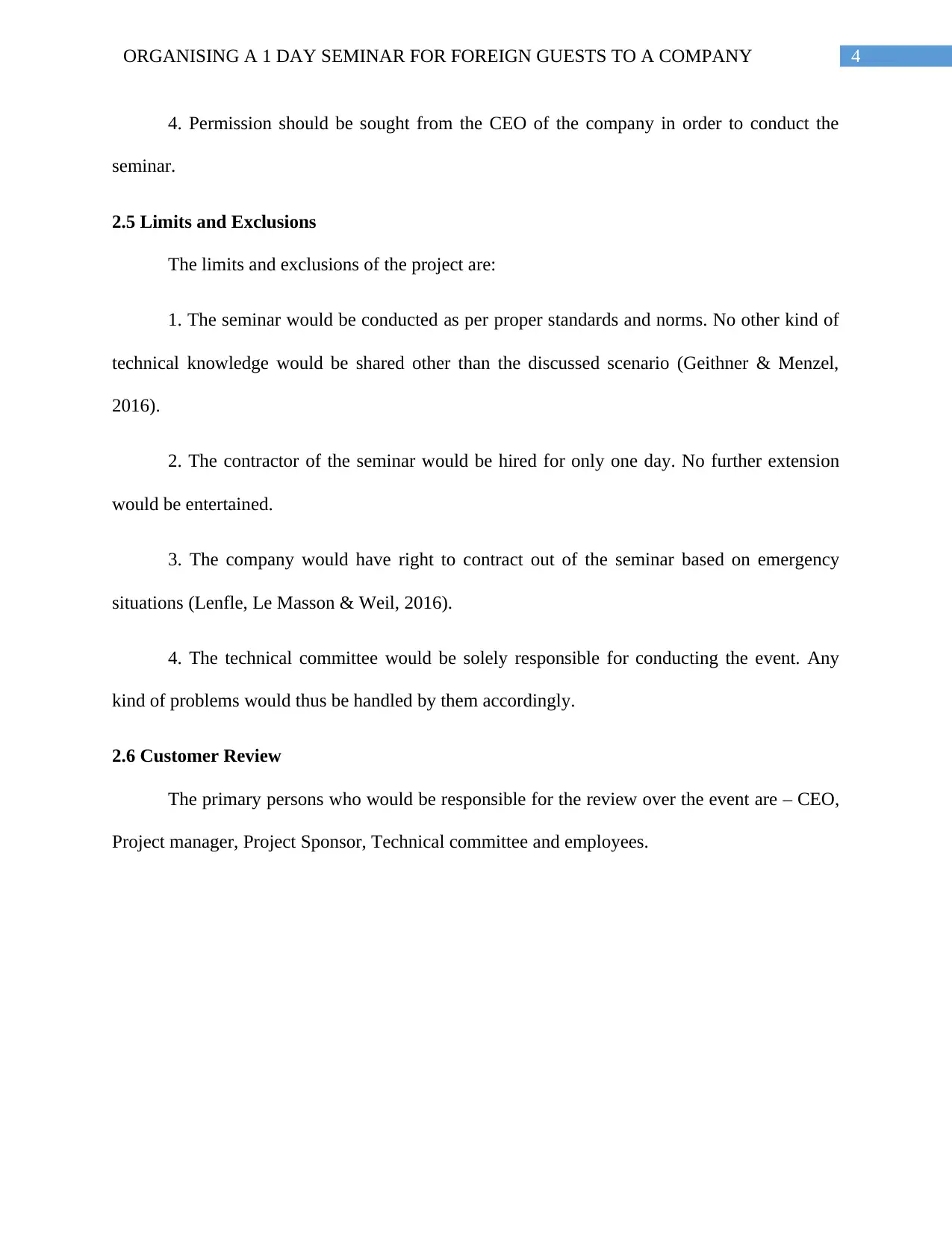
4ORGANISING A 1 DAY SEMINAR FOR FOREIGN GUESTS TO A COMPANY
4. Permission should be sought from the CEO of the company in order to conduct the
seminar.
2.5 Limits and Exclusions
The limits and exclusions of the project are:
1. The seminar would be conducted as per proper standards and norms. No other kind of
technical knowledge would be shared other than the discussed scenario (Geithner & Menzel,
2016).
2. The contractor of the seminar would be hired for only one day. No further extension
would be entertained.
3. The company would have right to contract out of the seminar based on emergency
situations (Lenfle, Le Masson & Weil, 2016).
4. The technical committee would be solely responsible for conducting the event. Any
kind of problems would thus be handled by them accordingly.
2.6 Customer Review
The primary persons who would be responsible for the review over the event are – CEO,
Project manager, Project Sponsor, Technical committee and employees.
4. Permission should be sought from the CEO of the company in order to conduct the
seminar.
2.5 Limits and Exclusions
The limits and exclusions of the project are:
1. The seminar would be conducted as per proper standards and norms. No other kind of
technical knowledge would be shared other than the discussed scenario (Geithner & Menzel,
2016).
2. The contractor of the seminar would be hired for only one day. No further extension
would be entertained.
3. The company would have right to contract out of the seminar based on emergency
situations (Lenfle, Le Masson & Weil, 2016).
4. The technical committee would be solely responsible for conducting the event. Any
kind of problems would thus be handled by them accordingly.
2.6 Customer Review
The primary persons who would be responsible for the review over the event are – CEO,
Project manager, Project Sponsor, Technical committee and employees.
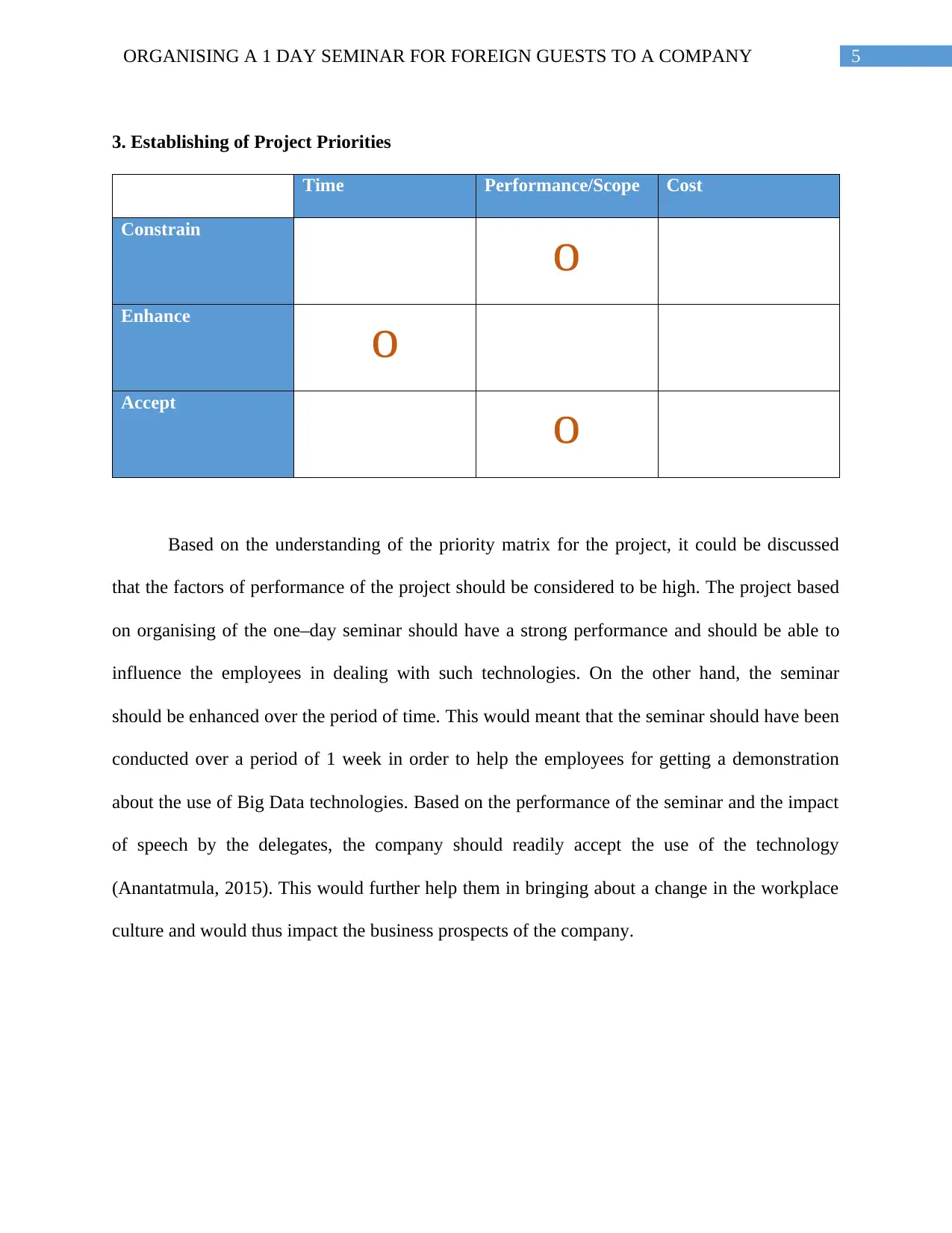
5ORGANISING A 1 DAY SEMINAR FOR FOREIGN GUESTS TO A COMPANY
3. Establishing of Project Priorities
Time Performance/Scope Cost
Constrain
ᴏ
Enhance
ᴏ
Accept
ᴏ
Based on the understanding of the priority matrix for the project, it could be discussed
that the factors of performance of the project should be considered to be high. The project based
on organising of the one–day seminar should have a strong performance and should be able to
influence the employees in dealing with such technologies. On the other hand, the seminar
should be enhanced over the period of time. This would meant that the seminar should have been
conducted over a period of 1 week in order to help the employees for getting a demonstration
about the use of Big Data technologies. Based on the performance of the seminar and the impact
of speech by the delegates, the company should readily accept the use of the technology
(Anantatmula, 2015). This would further help them in bringing about a change in the workplace
culture and would thus impact the business prospects of the company.
3. Establishing of Project Priorities
Time Performance/Scope Cost
Constrain
ᴏ
Enhance
ᴏ
Accept
ᴏ
Based on the understanding of the priority matrix for the project, it could be discussed
that the factors of performance of the project should be considered to be high. The project based
on organising of the one–day seminar should have a strong performance and should be able to
influence the employees in dealing with such technologies. On the other hand, the seminar
should be enhanced over the period of time. This would meant that the seminar should have been
conducted over a period of 1 week in order to help the employees for getting a demonstration
about the use of Big Data technologies. Based on the performance of the seminar and the impact
of speech by the delegates, the company should readily accept the use of the technology
(Anantatmula, 2015). This would further help them in bringing about a change in the workplace
culture and would thus impact the business prospects of the company.
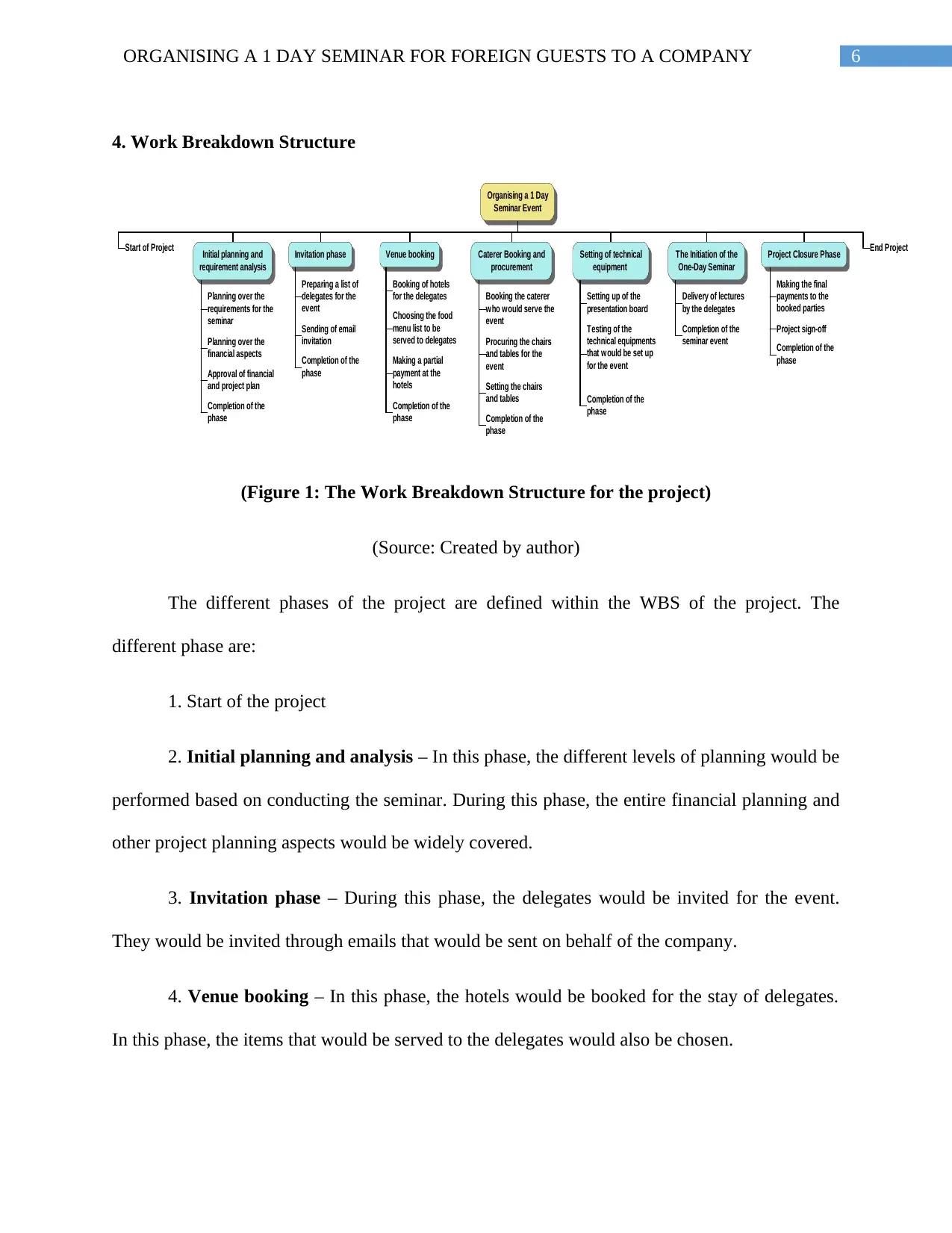
6ORGANISING A 1 DAY SEMINAR FOR FOREIGN GUESTS TO A COMPANY
4. Work Breakdown Structure
Organising a 1 Day
Seminar Event
Start of Project Initial planning and
requirement analysis
Planning over the
requirements for the
seminar
Planning over the
financial aspects
Approval of financial
and project plan
Completion of the
phase
Invitation phase
Preparing a list of
delegates for the
event
Sending of email
invitation
Completion of the
phase
Venue booking
Booking of hotels
for the delegates
Choosing the food
menu list to be
served to delegates
Making a partial
payment at the
hotels
Completion of the
phase
Caterer Booking and
procurement
Booking the caterer
w ho would serve the
event
Procuring the chairs
and tables for the
event
Setting the chairs
and tables
Completion of the
phase
Setting of technical
equipment
Setting up of the
presentation board
Testing of the
technical equipments
that would be set up
for the event
Completion of the
phase
The Initiation of the
One-Day Seminar
Delivery of lectures
by the delegates
Completion of the
seminar event
Project Closure Phase
Making the final
payments to the
booked parties
Project sign-off
Completion of the
phase
End Project
(Figure 1: The Work Breakdown Structure for the project)
(Source: Created by author)
The different phases of the project are defined within the WBS of the project. The
different phase are:
1. Start of the project
2. Initial planning and analysis – In this phase, the different levels of planning would be
performed based on conducting the seminar. During this phase, the entire financial planning and
other project planning aspects would be widely covered.
3. Invitation phase – During this phase, the delegates would be invited for the event.
They would be invited through emails that would be sent on behalf of the company.
4. Venue booking – In this phase, the hotels would be booked for the stay of delegates.
In this phase, the items that would be served to the delegates would also be chosen.
4. Work Breakdown Structure
Organising a 1 Day
Seminar Event
Start of Project Initial planning and
requirement analysis
Planning over the
requirements for the
seminar
Planning over the
financial aspects
Approval of financial
and project plan
Completion of the
phase
Invitation phase
Preparing a list of
delegates for the
event
Sending of email
invitation
Completion of the
phase
Venue booking
Booking of hotels
for the delegates
Choosing the food
menu list to be
served to delegates
Making a partial
payment at the
hotels
Completion of the
phase
Caterer Booking and
procurement
Booking the caterer
w ho would serve the
event
Procuring the chairs
and tables for the
event
Setting the chairs
and tables
Completion of the
phase
Setting of technical
equipment
Setting up of the
presentation board
Testing of the
technical equipments
that would be set up
for the event
Completion of the
phase
The Initiation of the
One-Day Seminar
Delivery of lectures
by the delegates
Completion of the
seminar event
Project Closure Phase
Making the final
payments to the
booked parties
Project sign-off
Completion of the
phase
End Project
(Figure 1: The Work Breakdown Structure for the project)
(Source: Created by author)
The different phases of the project are defined within the WBS of the project. The
different phase are:
1. Start of the project
2. Initial planning and analysis – In this phase, the different levels of planning would be
performed based on conducting the seminar. During this phase, the entire financial planning and
other project planning aspects would be widely covered.
3. Invitation phase – During this phase, the delegates would be invited for the event.
They would be invited through emails that would be sent on behalf of the company.
4. Venue booking – In this phase, the hotels would be booked for the stay of delegates.
In this phase, the items that would be served to the delegates would also be chosen.
Paraphrase This Document
Need a fresh take? Get an instant paraphrase of this document with our AI Paraphraser
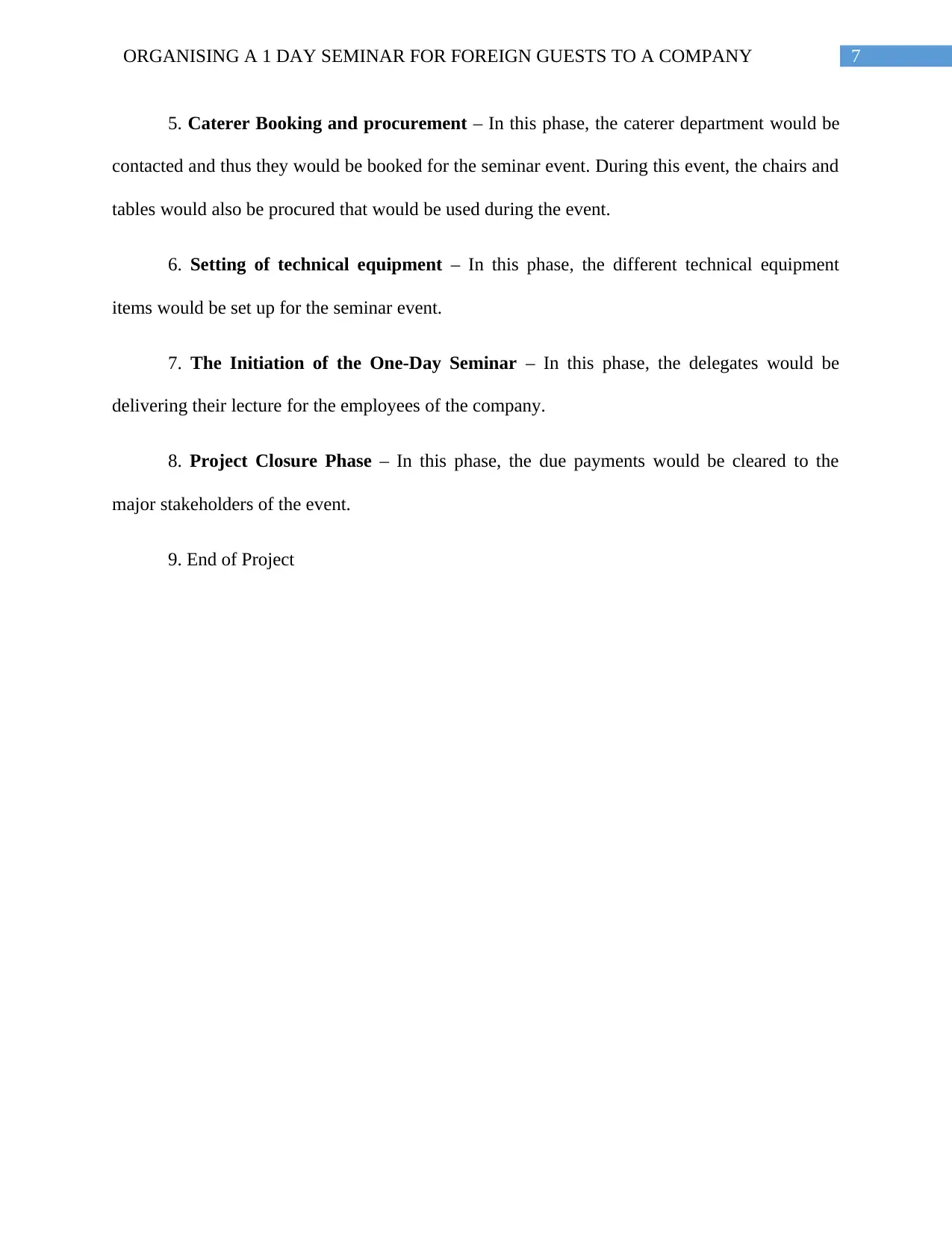
7ORGANISING A 1 DAY SEMINAR FOR FOREIGN GUESTS TO A COMPANY
5. Caterer Booking and procurement – In this phase, the caterer department would be
contacted and thus they would be booked for the seminar event. During this event, the chairs and
tables would also be procured that would be used during the event.
6. Setting of technical equipment – In this phase, the different technical equipment
items would be set up for the seminar event.
7. The Initiation of the One-Day Seminar – In this phase, the delegates would be
delivering their lecture for the employees of the company.
8. Project Closure Phase – In this phase, the due payments would be cleared to the
major stakeholders of the event.
9. End of Project
5. Caterer Booking and procurement – In this phase, the caterer department would be
contacted and thus they would be booked for the seminar event. During this event, the chairs and
tables would also be procured that would be used during the event.
6. Setting of technical equipment – In this phase, the different technical equipment
items would be set up for the seminar event.
7. The Initiation of the One-Day Seminar – In this phase, the delegates would be
delivering their lecture for the employees of the company.
8. Project Closure Phase – In this phase, the due payments would be cleared to the
major stakeholders of the event.
9. End of Project
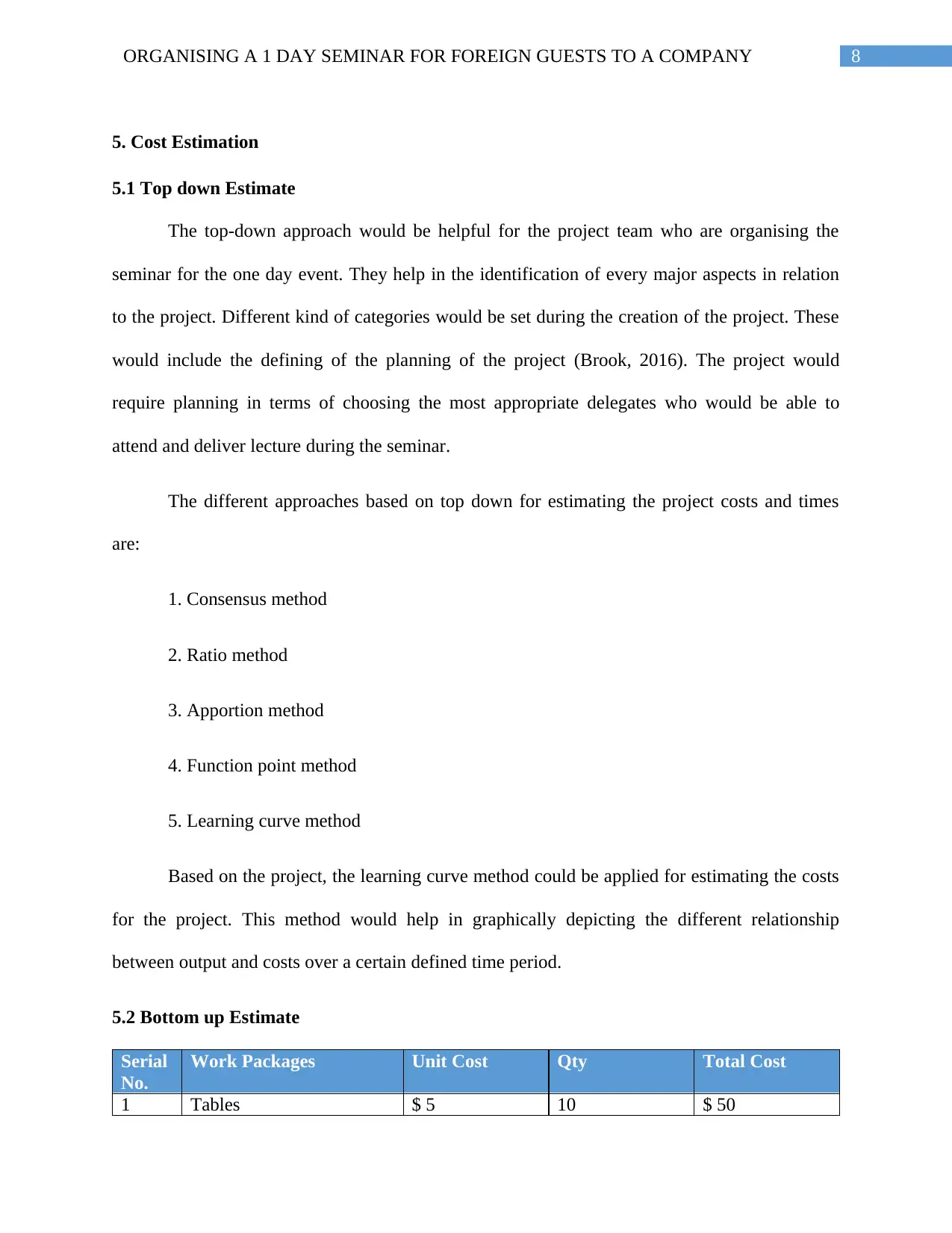
8ORGANISING A 1 DAY SEMINAR FOR FOREIGN GUESTS TO A COMPANY
5. Cost Estimation
5.1 Top down Estimate
The top-down approach would be helpful for the project team who are organising the
seminar for the one day event. They help in the identification of every major aspects in relation
to the project. Different kind of categories would be set during the creation of the project. These
would include the defining of the planning of the project (Brook, 2016). The project would
require planning in terms of choosing the most appropriate delegates who would be able to
attend and deliver lecture during the seminar.
The different approaches based on top down for estimating the project costs and times
are:
1. Consensus method
2. Ratio method
3. Apportion method
4. Function point method
5. Learning curve method
Based on the project, the learning curve method could be applied for estimating the costs
for the project. This method would help in graphically depicting the different relationship
between output and costs over a certain defined time period.
5.2 Bottom up Estimate
Serial
No.
Work Packages Unit Cost Qty Total Cost
1 Tables $ 5 10 $ 50
5. Cost Estimation
5.1 Top down Estimate
The top-down approach would be helpful for the project team who are organising the
seminar for the one day event. They help in the identification of every major aspects in relation
to the project. Different kind of categories would be set during the creation of the project. These
would include the defining of the planning of the project (Brook, 2016). The project would
require planning in terms of choosing the most appropriate delegates who would be able to
attend and deliver lecture during the seminar.
The different approaches based on top down for estimating the project costs and times
are:
1. Consensus method
2. Ratio method
3. Apportion method
4. Function point method
5. Learning curve method
Based on the project, the learning curve method could be applied for estimating the costs
for the project. This method would help in graphically depicting the different relationship
between output and costs over a certain defined time period.
5.2 Bottom up Estimate
Serial
No.
Work Packages Unit Cost Qty Total Cost
1 Tables $ 5 10 $ 50
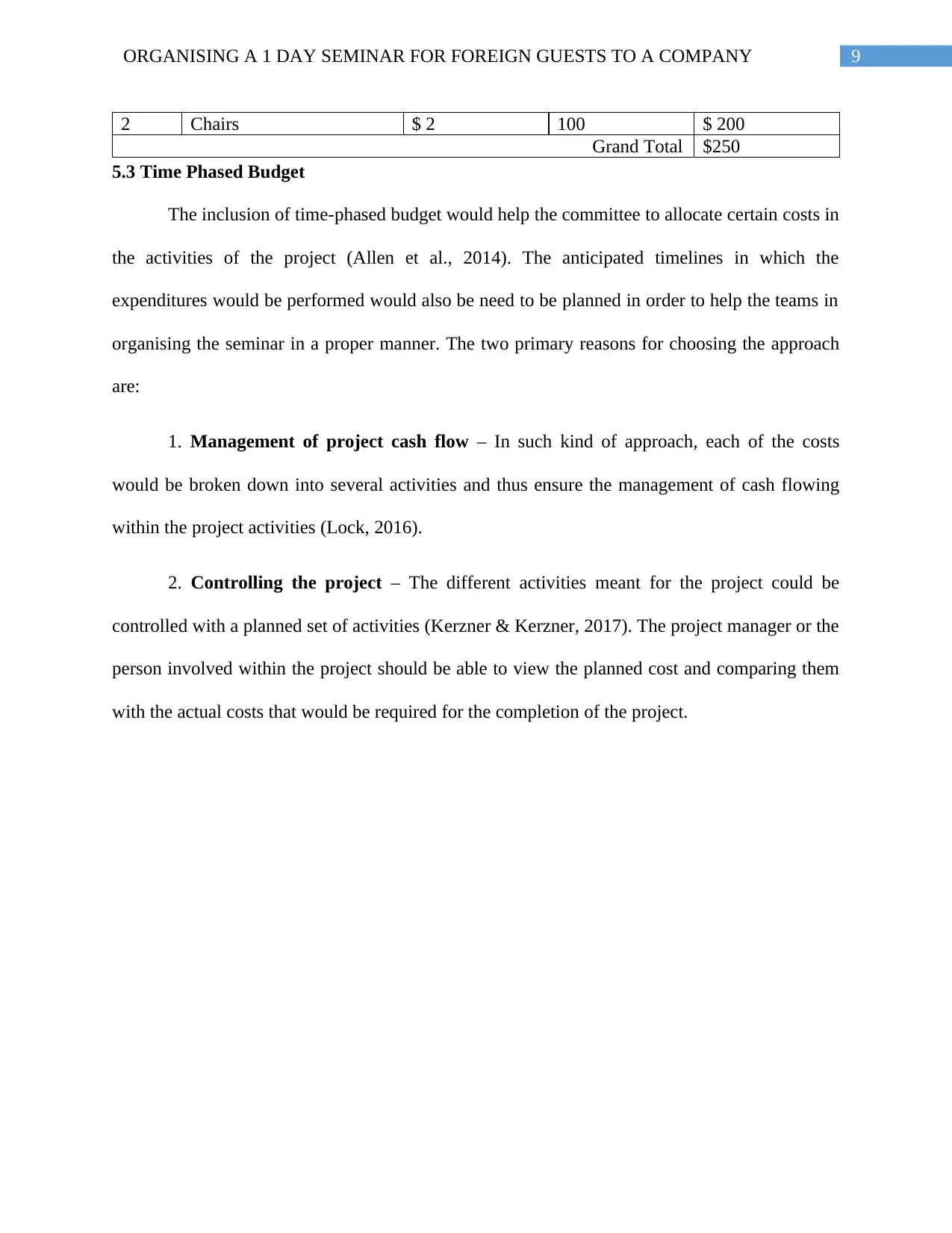
9ORGANISING A 1 DAY SEMINAR FOR FOREIGN GUESTS TO A COMPANY
2 Chairs $ 2 100 $ 200
Grand Total $250
5.3 Time Phased Budget
The inclusion of time-phased budget would help the committee to allocate certain costs in
the activities of the project (Allen et al., 2014). The anticipated timelines in which the
expenditures would be performed would also be need to be planned in order to help the teams in
organising the seminar in a proper manner. The two primary reasons for choosing the approach
are:
1. Management of project cash flow – In such kind of approach, each of the costs
would be broken down into several activities and thus ensure the management of cash flowing
within the project activities (Lock, 2016).
2. Controlling the project – The different activities meant for the project could be
controlled with a planned set of activities (Kerzner & Kerzner, 2017). The project manager or the
person involved within the project should be able to view the planned cost and comparing them
with the actual costs that would be required for the completion of the project.
2 Chairs $ 2 100 $ 200
Grand Total $250
5.3 Time Phased Budget
The inclusion of time-phased budget would help the committee to allocate certain costs in
the activities of the project (Allen et al., 2014). The anticipated timelines in which the
expenditures would be performed would also be need to be planned in order to help the teams in
organising the seminar in a proper manner. The two primary reasons for choosing the approach
are:
1. Management of project cash flow – In such kind of approach, each of the costs
would be broken down into several activities and thus ensure the management of cash flowing
within the project activities (Lock, 2016).
2. Controlling the project – The different activities meant for the project could be
controlled with a planned set of activities (Kerzner & Kerzner, 2017). The project manager or the
person involved within the project should be able to view the planned cost and comparing them
with the actual costs that would be required for the completion of the project.
Secure Best Marks with AI Grader
Need help grading? Try our AI Grader for instant feedback on your assignments.

10ORGANISING A 1 DAY SEMINAR FOR FOREIGN GUESTS TO A COMPANY
References
Allen, M., Alleyne, D., Farmer, C., McRae, A., & Turner, C. (2014). A framework for project
success. Journal of Information Technology and Economic Development, 5(2), 1.
Anantatmula, V. S. (2015). Strategies for enhancing project performance. Journal of
Management in Engineering, 31(6), 04015013.
Brook, M. (2016). Estimating and tendering for construction work. Routledge.
Geithner, S., & Menzel, D. (2016). Effectiveness of learning through experience and reflection in
a project management simulation. Simulation & Gaming, 47(2), 228-256.
Kerzner, H., & Kerzner, H. R. (2017). Project management: a systems approach to planning,
scheduling, and controlling. John Wiley & Sons.
Lenfle, S., Le Masson, P., & Weil, B. (2016). When project management meets design theory:
revisiting the Manhattan and Polaris projects to characterize ‘radical innovation’and its
managerial implications. Creativity and Innovation Management, 25(3), 378-395.
Lock, D. (2016). Project Management in Construction. Routledge.
Oliveira, F., Goldman, A., & Santos, V. (2015, August). Managing technical debt in software
projects using scrum: An action research. In 2015 Agile Conference (pp. 50-59). IEEE.
Silvius, G. (2017). Sustainability as a new school of thought in project management. Journal of
cleaner production, 166, 1479-1493.
Turkulainen, V., Aaltonen, K., & Lohikoski, P. (2015). Managing project stakeholder
communication: the Qstock festival case. Project Management Journal, 46(6), 74-91.
References
Allen, M., Alleyne, D., Farmer, C., McRae, A., & Turner, C. (2014). A framework for project
success. Journal of Information Technology and Economic Development, 5(2), 1.
Anantatmula, V. S. (2015). Strategies for enhancing project performance. Journal of
Management in Engineering, 31(6), 04015013.
Brook, M. (2016). Estimating and tendering for construction work. Routledge.
Geithner, S., & Menzel, D. (2016). Effectiveness of learning through experience and reflection in
a project management simulation. Simulation & Gaming, 47(2), 228-256.
Kerzner, H., & Kerzner, H. R. (2017). Project management: a systems approach to planning,
scheduling, and controlling. John Wiley & Sons.
Lenfle, S., Le Masson, P., & Weil, B. (2016). When project management meets design theory:
revisiting the Manhattan and Polaris projects to characterize ‘radical innovation’and its
managerial implications. Creativity and Innovation Management, 25(3), 378-395.
Lock, D. (2016). Project Management in Construction. Routledge.
Oliveira, F., Goldman, A., & Santos, V. (2015, August). Managing technical debt in software
projects using scrum: An action research. In 2015 Agile Conference (pp. 50-59). IEEE.
Silvius, G. (2017). Sustainability as a new school of thought in project management. Journal of
cleaner production, 166, 1479-1493.
Turkulainen, V., Aaltonen, K., & Lohikoski, P. (2015). Managing project stakeholder
communication: the Qstock festival case. Project Management Journal, 46(6), 74-91.
1 out of 11
Related Documents
Your All-in-One AI-Powered Toolkit for Academic Success.
+13062052269
info@desklib.com
Available 24*7 on WhatsApp / Email
![[object Object]](/_next/static/media/star-bottom.7253800d.svg)
Unlock your academic potential
© 2024 | Zucol Services PVT LTD | All rights reserved.





